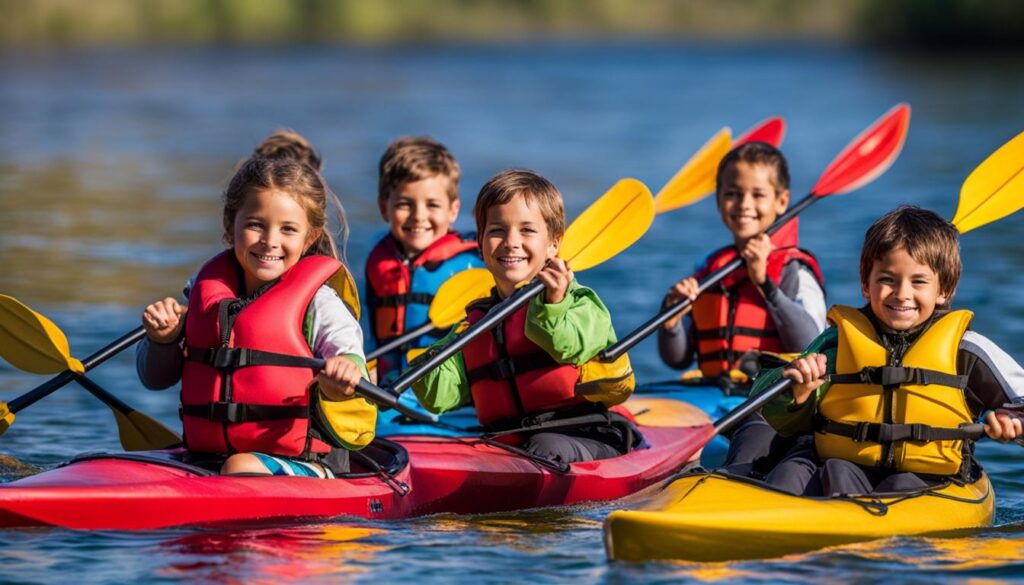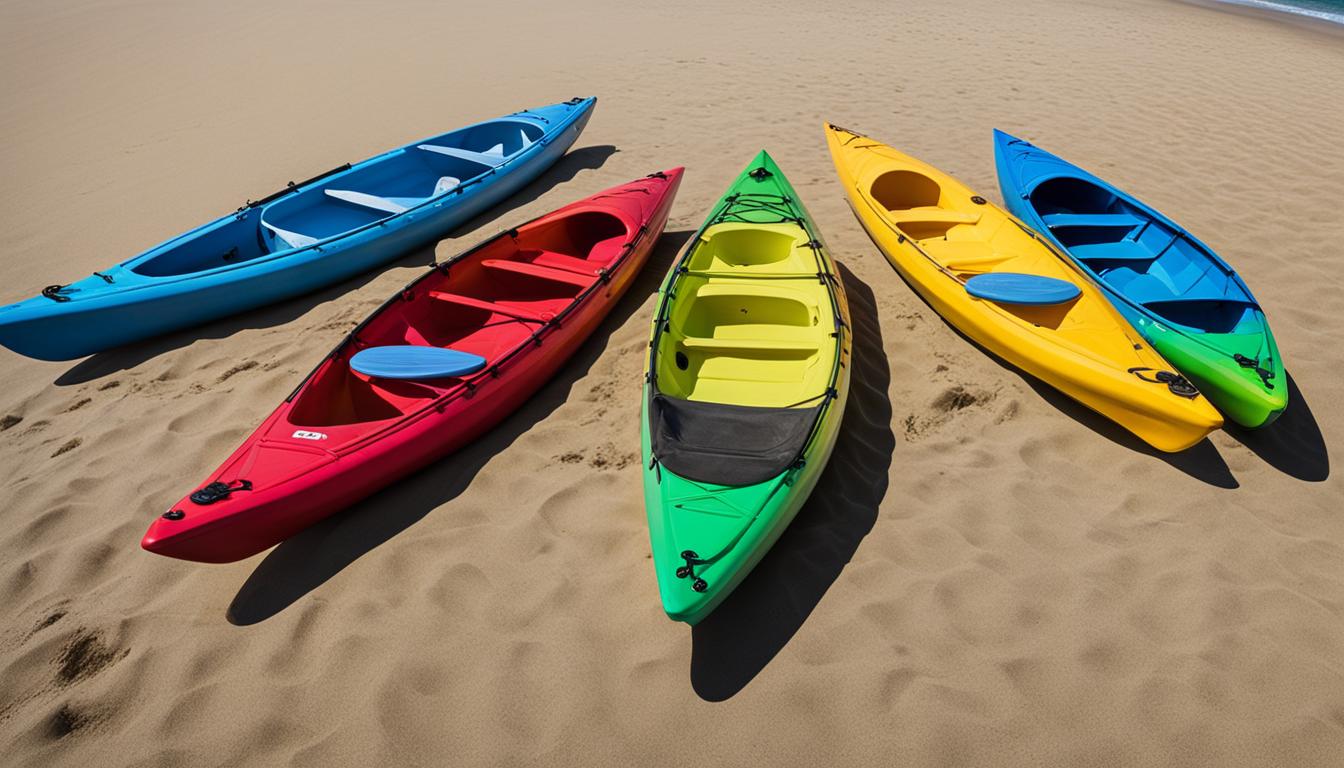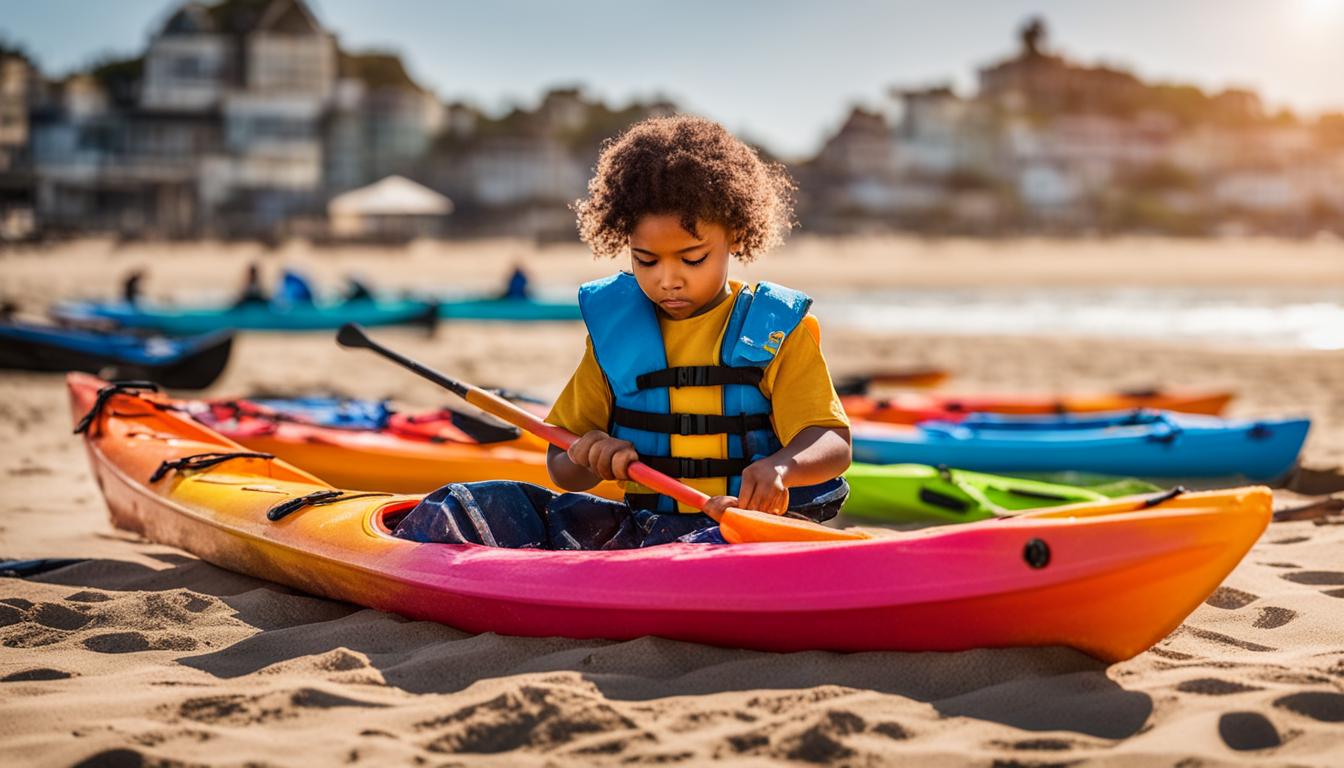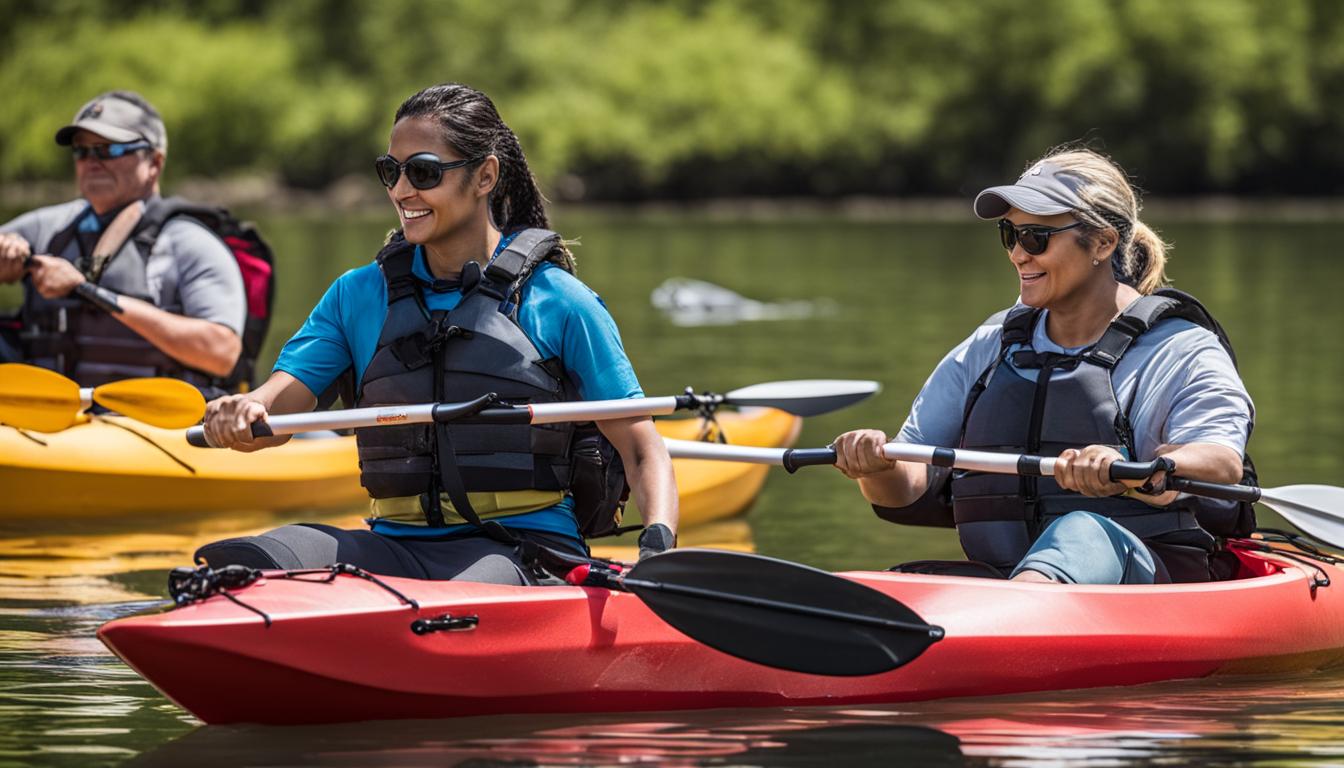Choosing the right kayak for your child is essential to ensure a safe and enjoyable paddling experience. The size and weight of the kayak play a significant role in determining its performance and suitability for young paddlers. By considering factors such as your child’s weight, height, and skill level, you can select the perfect kayak that offers comfort, stability, and the right level of challenge.
When selecting a kids kayak, it’s important to keep in mind that longer kayaks provide more speed, while wider kayaks offer better stability. The right kayak size for young paddlers depends on their age, size, and paddling goals. To help you make an informed decision, we’ve gathered valuable information from reliable sources to guide you in choosing the appropriate kayak length and width for your child.
Key Takeaways:
- Consider your child’s weight, height, and skill level when selecting a children’s kayak.
- Longer kayaks provide more speed, while wider kayaks offer better stability.
- Choose the kayak size that suits your child’s paddling goals and comfort.
- Ensure the kayak’s weight capacity accommodates your child’s weight and any additional gear.
- By choosing the right size kayak, you can enhance your child’s paddling experience and promote their love for kayaking.
Different Types of Children’s Kayaks
When it comes to children’s kayaks, there are various types available to suit their paddling needs and skill levels. Understanding the different options can help parents make an informed decision and ensure that their child has an enjoyable kayaking experience.
Recreational Kayaks for Kids
Recreational kayaks are an excellent choice for beginners and young paddlers. These kayaks are typically shorter and wider, offering increased stability and maneuverability. They are designed for calm waters such as lakes and slow-moving rivers, making them ideal for kids who are just starting to explore kayaking. Recreational kayaks provide a stable platform for learning basic paddling techniques and building confidence on the water.
Day Touring Kayaks for Children
For children who have gained some experience and are ready to venture beyond calm waters, day touring kayaks are a suitable option. These kayaks are slightly longer and narrower than recreational kayaks, offering improved speed and efficiency. They are designed for longer distances and can handle moderate waves and currents. Day touring kayaks provide a balance between stability and performance, allowing young paddlers to explore a wider range of water conditions.
Touring Kayaks for Young Paddlers
For more experienced young paddlers looking for more challenging adventures, touring kayaks, also known as sea kayaks, are an excellent choice. These kayaks are longer and narrower, making them faster and more efficient in the water. They are designed for multi-day trips and can handle rougher conditions, such as open water and coastal areas. Touring kayaks offer superior tracking and stability, allowing young paddlers to explore and navigate more demanding water environments with confidence.
Each type of children’s kayak offers unique features and benefits, catering to different skill levels and paddling goals. It is essential for parents to consider their child’s experience, comfort, and the type of water they will be kayaking in when making a selection. By choosing the right type of kayak, parents can ensure that their child has a positive and enjoyable kayaking experience.

Kayak Type Comparison:
| Kayak Type | Features | Best For |
|---|---|---|
| Recreational Kayaks | Shorter, wider, stable | Beginners, calm waters |
| Day Touring Kayaks | Longer, narrower, faster | Intermediate paddlers, longer distances |
| Touring Kayaks | Long, narrow, superior tracking | Experienced paddlers, challenging water conditions |
Choosing the Right Size Kayak for Children
When it comes to choosing a kayak for your child, finding the right size is essential. You want to ensure a comfortable and safe paddling experience that promotes confidence and enjoyment on the water. To make an informed decision, consider the child’s height, weight, and paddling goals.
Firstly, let’s discuss height and weight. The size of the kayak should match the child’s proportions for optimal performance. A kayak that is too long or too wide may be challenging to control, while one that is too small may restrict movement and cause discomfort. As a general rule, the kayak’s length should be around 1.5 times the child’s height. For example, if your child is 4 feet tall (48 inches), a kayak between 6 and 7.5 feet in length would be suitable. Additionally, the weight capacity of the kayak should accommodate the child’s weight and any gear they may carry.
Secondly, take into account the child’s paddling goals. Are they looking to explore calm lakes and slow-moving rivers, or are they interested in more adventurous waters? For shorter distances and easy maneuverability, a shorter kayak is recommended. Shorter kayaks provide better control and responsiveness, making them ideal for beginners and those looking for recreational paddling experiences. On the other hand, if your child aspires to go on longer trips or tackle challenging water conditions, a longer kayak offers improved speed and stability.
| Kayak Length | Ideal Paddling Goals |
|---|---|
| 7-9 feet | Recreational paddling, calm lakes, slow-moving rivers |
| 9-12 feet | Day trips, moderate paddling conditions |
| 12+ feet | Multi-day trips, challenging water conditions |
Remember, the key is to strike a balance between length and width based on your child’s height, weight, and paddling goals. By doing so, you can provide them with a kayak that offers stability, comfort, and the ability to grow and develop their paddling skills.
Lastly, consider the width of the kayak. Wider kayaks provide greater stability, making them more suitable for beginners and younger children. However, if your child is older or more experienced, a narrower kayak can offer improved speed and maneuverability. It is essential to find a width that allows the child to feel secure and comfortable, as this will enhance their confidence and enjoyment on the water.
By selecting a kayak based on your child’s height and weight, considering their paddling goals, and finding the right balance between length and width, you can ensure that their kayaking experience is both safe and enjoyable. Investing time in choosing the right size kayak will set the foundation for a lifetime of paddling adventures.

Key Features and Accessories for Children’s Kayaks
When it comes to children’s kayaks, there are several key features and accessories that can enhance their paddling experience. These include stability and maneuverability, comfortable seating, safety features, and essential accessories.
Stability and Maneuverability
Stability and maneuverability are crucial factors to consider when choosing a kayak for young paddlers. Kids kayaks should be designed with a wide and flat hull, providing stability on the water. This allows children to feel confident and secure while paddling. Additionally, kayaks with a shorter length are easier to maneuver, making it more enjoyable for kids to navigate through different water conditions.
Comfortable Seating
Comfortable seating is essential for young paddlers to have an enjoyable experience on the water. Look for kayaks that have adjustable seats, allowing you to customize the position for optimal comfort and support. A well-padded seat will also help prevent discomfort during longer paddling trips. Providing your child with a comfortable seating arrangement will ensure they can focus on the adventure and have a great time kayaking.
Safety Features
Safety is of utmost importance when it comes to children’s kayaks. Look for kayaks that include safety features such as grab handles, which allow for easy entry and exit from the kayak. Brightly colored kayaks increase visibility, making it easier to spot your child on the water. These safety features not only provide peace of mind for parents but also help ensure the well-being of young paddlers.
Essential Accessories
In addition to the key features, there are essential accessories that can enhance your child’s kayaking experience. A lightweight paddle with a smaller blade is easier for children to handle and maneuver. It is also important to provide your child with a properly fitting life jacket, ensuring their safety at all times. Depending on the water conditions, a helmet may be necessary to provide added protection. These accessories will help your child feel confident and prepared for their kayaking adventures.
By considering these key features and accessories, you can choose a children’s kayak that provides stability, comfort, and safety for your young paddler. These elements will contribute to a fun and memorable experience on the water, allowing your child to develop a love for kayaking from an early age.
| Key Features | Benefits |
|---|---|
| Stability and Maneuverability | Confidence and ease of paddling |
| Comfortable Seating | Enhanced comfort and support |
| Safety Features | Increased visibility and peace of mind |
| Essential Accessories | Better control and safety on the water |
Conclusion
Choosing the right size kayak for your child is essential in providing them with a safe and enjoyable paddling experience. By considering factors such as kayak type, size, key features, and necessary accessories, you can find the best kids kayak for your little adventurer.
Kayaking is a wonderful activity that fosters a love for the outdoors and offers numerous benefits for children. Not only does it provide physical exercise, but it also stimulates their minds and allows for family bonding time on the water.
So why wait? Start your child’s kayaking journey today and create lasting memories. Let them experience the thrill of gliding through the water and discovering the beauty of nature. With the right children’s kayak, you can nurture their passion for kayaking and open their eyes to a world of adventure.
FAQ
How do I choose the right size kayak for my child?
When choosing a kayak for your child, consider their weight, height, and skill level. A shorter kayak is recommended for shorter distances and easy maneuverability, while the width should provide stability and comfort.
What types of kayaks are suitable for children?
There are different types of kayaks for children based on their paddling needs and skill level. Recreational kayaks are short and wide, day touring kayaks are slightly longer and narrower, and touring kayaks are long and narrow designed for multi-day trips.
What features should children’s kayaks have?
Children’s kayaks should prioritize stability and maneuverability with a wide and flat hull design. The seating should be comfortable and adjustable, and safety features like grab handles and brightly colored kayaks enhance visibility and safety on the water.
What accessories do children’s kayaks require?
Essential accessories for kids’ kayaks include a lightweight paddle with a smaller blade, a properly fitting life jacket, and, depending on the conditions, a helmet for added protection.
What are the benefits of kayaking for children?
Kayaking offers numerous benefits for children, including physical exercise, mental stimulation, and opportunities for family bonding.





